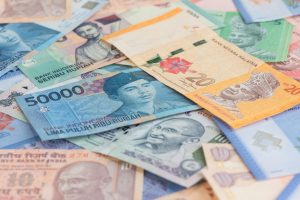When assessing the economic health of a country, one of the more common metrics is to look at the state of the current account. The current account measures the inflow of goods, services, and income relative to outflow. Generally speaking, emerging markets do not like to run current account deficits because it can drive up the cost of external borrowing and increase vulnerability to financial shocks.
People usually look at the balance of trade – net exports and imports of tradable goods – when they talk about the current account. But services like tourism and airfares are also an important component, as are primary and secondary income. Primary income represents profits and interest paid or received on assets like bonds and equities (dividends paid to a foreign owner of an Indonesian stock would be counted as a debit in the primary income account), while secondary income represents cash transfers such as remittances.
A lot of people stop at the balance of trade, but you have to look at all four to get the full picture. According to central bank data in the first quarter of 2021 the Philippines had a modest current account deficit of $614.5 million, despite a net balance in tradable goods and services of negative $8.2 billion. Normally such an imbalance would hit the current account hard, but in the Philippines it was largely cancelled out by $7 billion of secondary income, mostly from overseas remittances.
Malaysia poses a counterexample, keeping its current account in surplus throughout the pandemic the old-fashioned way: by exporting more goods. According to the Central Bank of Malaysia, in the second quarter of 2021 exports surged to 244 billion ringgit ($58 billion). This is apparently being driven by strong global demand for commodities like palm oil, as well as semiconductors. That strong performance allowed the country to maintain an overall current account surplus even as Malaysia runs deficits in services and income.
If you only looked at the balance of trade you would think something similar was happening in Thailand, where the export of agricultural and manufactured goods rebounded in the first half of the year after taking a hit in 2020. The Bank of Thailand reports that as of June 2021 the country was running a surplus in tradable goods of $17.1 billion, with exports already reaching 58 percent of last year’s total. But this has been offset by a $25.7 billion deficit in the income and services category, resulting in a current account balance of negative $8.6 billion through the first two quarters of the year. This is probably due primarily to the cratering of Thailand’s tourism industry, which accounts for a big chunk of service exports.
Without those, and the foreign exchange they generate, it is going to be difficult for Thailand to run a current account surplus this year, even as exports of goods recover. This is also why they have placed such a premium on the Phuket Sandbox and the revival of international tourism, and keep holding out hope that it will work despite all evidence to the contrary. Without those service exports, Thailand’s current account will likely remain in deficit, to Bangkok’s dismay.
We might expect Indonesia, which has also seen tourism dry up, to suffer the same fate. But Indonesia is more comfortable running deficits and is actually doing less of that than before the pandemic. According to Bank Indonesia, the current account deficit shrank from $30.3 billion in 2019 to just $4.5 billion last year. As of June 2021, the current account was running a $3.3 billion deficit, well-below its pre-pandemic level.
Like Malaysia, Indonesia has been doing a booming trade in exported goods. And while service exports did contract significantly with the loss of tourism revenue, service imports (such as airline tickets purchased domestically from foreign carriers) also contracted, so the effect hasn’t been as pronounced.
More significant is that the deficit in Indonesia’s primary income account shrank by $4.9 billion from 2019 to 2020. This is because there was a big reduction of inward investment and Indonesia’s pandemic-battered businesses paid out a lot less to foreign investors in 2020, a trend that looks to be holding through the first half of 2021. This might be considered suboptimal from a business point of view, but from a balance of payment perspective it does help to shore up the current account.
I should add that this data largely predates the new round of lockdowns in the region, and the Federal Reserve’s response to short-term inflation in the United States could change things pretty significantly by the end of the year. But this little snapshot shows that while trade is important as countries seek to bounce back from COVID-19, you need to poke a little deeper to get a full picture of the current account and what it means for the underlying economic situation.

































